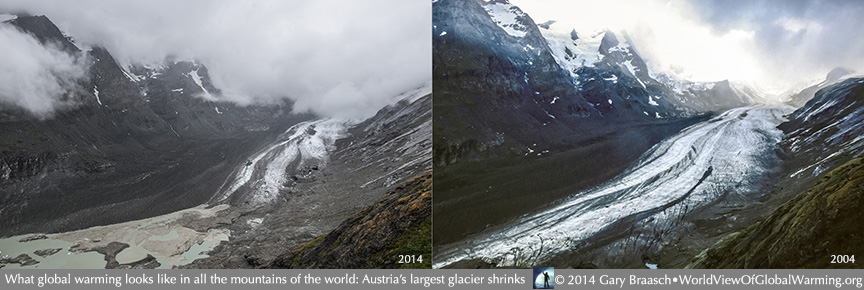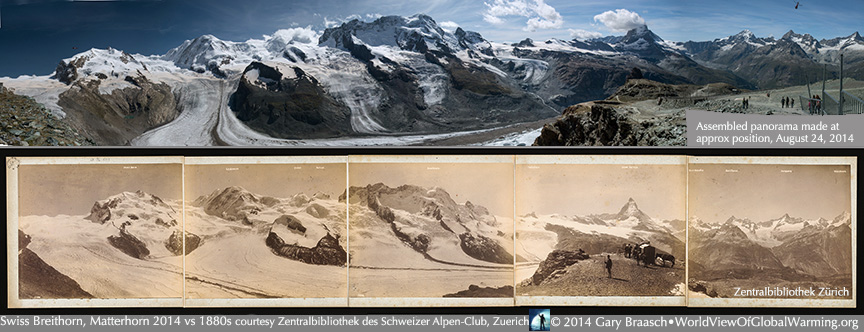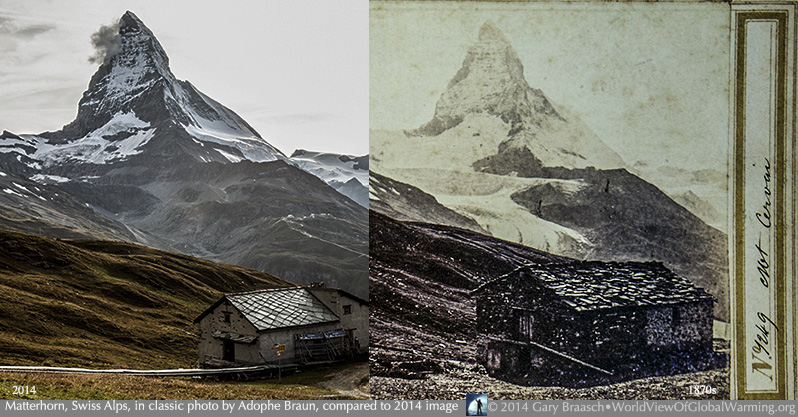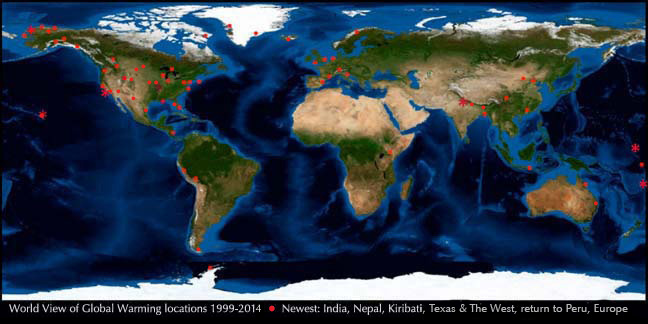Climate Photo of the Week
Glaciers of the world wither at a rate “without precedent” under record warmth continuing in 2015; fresh water loss is the major threat.

Pasterze Glacier, longest in Austria, withers in only ten years, August 2004 to 2014, a rapid retreat that is being repeated in all the mountain ranges of the world under increasing global warming -- which continues at a record level in 2015. NOAA calculations show this year is running a tenth of a degree C warmer (.18 deg F) than 2014, a great jump over that previous warmest year on record. El Nino, the global ocean and atmospheric warming cycle was not a factor last year, but it is now, and is likely to turn up readings even higher, NOAA says.

The Pasterze glacier and others in the Alps, like the once valley filling glaciers of the Breithorn-Matterhorn massif above Zermatt and disappearing ice in the Andes and elsewhere were rephotographed recently by World View of Global Warming. They are representative of mountain glaciers on all continents which are melting and thinning “without precedent” in recorded history, according to glaciologists. The latest review of 42,000 glacier measurements made since the year 1600 compiled by the World Glacier Monitoring Service (WGMS) says the loss of glacier mass in the early 21st century is a global phenomenon. Loss of glaciers might be seen merely as a rebound from the cooler period in the 16th -18th C called the Little Ice Age. However glacial recession and thinning are happening in every mountain range of the world, and the pace has increased—in some areas, the loss of ice is occurring twice as fast as it was thirty years ago. There are only a few very local exceptions. Low latitude mountain ranges are the most at risk. This includes the Rockies, the Andes, Alps, Pyrenees, Caucasus, Scandinavia, the African Rift, Indonesia and the Southern Alps. Glaciers there may be melted far back into the highest cirques by 2100 because of the inertia of planetary warming that is already set in motion by the current CO2 concentration of 400 ppm.

The significance of the loss of this ice held high in the great ranges of the world can be summed up in two words: fresh water. Less than 3 percent of Earth’s water is fresh, and seventy percent of that is frozen at the poles. The remaining small part of Earth’s available fresh water that is in mountain glaciers makes them life-supporting frozen reservoirs. They hold a hundred times more water than is in the world’s temperate and tropical rivers. Half the human population uses water from mountains for drinking, irrigation, industry, food and energy production. More than a billion people depend directly on the flow from glaciers and seasonal snow. About 40 percent of the world’s irrigation is supported by flows originating from large mountain systems.
Commercial river water uses like navigation, irrigation and hydroelectric generation will become less certain. Mountain peoples will face drought, as will great lowland cities from China to South America to the American West — already seen this year in California, Oregon and Washington.
For information and archival photographs of the Alps, we are indebted to Yves Bislex, Association Valaisanne d'Images Anciennes; Thomas Germann, Zentralbibliothek des Schweizer Alpen-Club, Zuerich; and Dr. Mark Andreas Seiler. For more glacier images, please see http://www.worldviewofglobalwarming.org/gallery/Glaciers/index.php
Update: U.S. slams door on Arctic Ocean oil drilling in near future, as Shell pulls out of its failed 2015 operation

No more Arctic Ocean oil drilling leases will be allowed by the U.S. Government in the coming two years, the Interior Department announced on October 16. It also rejected requests by two oil companies to extend their current leases. These decisions effectively stop the current American Arctic Ocean oil drilling program, which began in 2008 with oil lease sales by the G. W. Bush administration, and came to a surprising end on September 28 this year when Royal Dutch Shell said it had not found sufficient oil at its lease site. The end of the drilling in the Chukchi Sea 80 miles NW of the Alaska coast and canceling of new lease sales fulfills the major goals of the environmental community. Shell’s drilling action and its approval by the government this year were subject of continuing public opposition, demonstrations and many analysts, editorial and political commentaries. Secretary of the Interior Sally Jewell said the decision to stop the leasing program was baed on low energy prices, Shell’s decision to stop and the fact that many leases remain in effect although inactive for now.
For more on Shell’s drilling program and our coverage of events this year, please see here, here and here. For more on the American Arctic, please see BraaschPhotography.com.
15 years of World View of Global Warming, documenting climate change 1999-2015

This project would be impossible without scientists and observers around the world who have provided hundreds of scientific contacts and papers. See Background, Advisors, and Reference for documentation, funders and major advisors, without whom I could not complete the work.
World View of Global Warming is a project of the Blue Earth Alliance, Seattle Washington, a 501(c)3 tax-exempt organization. The project is supported entirely by donations, grants, and license fees for the photographs. Please see information about how to contribute.
For other information about Gary Braasch's climate change projects and books, please see the books Earth Under Fire and How We Know What We Know About Our Changing Climate, and the exhibit "Climate Change in Our World" at the Books and Exhibits link on the top menu of this page.
COPYRIGHT NOTICE:
Photography and text Copyright © 2005 - 2017 (and before) Gary Braasch All rights reserved. Use of photographs in any manner without permission is prohibited by US copyright law. Photography is available for license to publications and other uses. Please contact requestinformation@worldviewofglobalwarming.org. View more of Gary Braasch's photography here.



